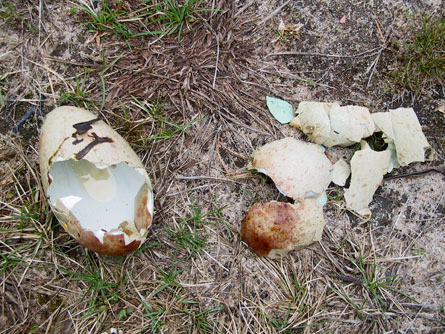Article #7 in a Series
by Jane Duden
Nesting's Not Easy
For the reintroduced eastern flock nesting in Wisconsin, the scorecard has been more losses than expected. What's going wrong?
Cranes build nests in marshy areas to keep babies safer from predators.
Eva Szyszkoski
After 15 years of putting birds into the new flock, the biggest problem was this: Not enough babies survived to grow up and become parents themselves. In 2015, for example, a record 24 chicks hatched from 37 nests but only two lived to fledge and migrate. In 2016, 23 chicks hatched at Necedah NWR but none survived to fledge. Why hasn't the flock had much luck raising babies?
| Nests Fail: Why? | ||
| Nest Predation When a pair of Whooping Cranes starts nesting, very often one or both eggs are stolen by a raccoon, skunk, larger predator, or other animal. Cranes are adapted to deal with this. If one egg is taken, the female lays another egg. If this egg, too, is taken, she lays yet another. |
||
 |
||
| Vulnerable to Predation Richard Urbanek |
||
| Nest Abandonment At Necedah NWR, a big culprit was tiny black flies. They hatch, then bite and pester the cranes right off their nests before the eggs can hatch. |
 |
|
| Eggs with Black Flies WCEP |
||
Inexperience
|
||
 |
||
| What Happened? WCEP |
||
Low Chick Survival: Why?
Human babies don't come with instructions, and Whooping Crane eggs don't, either. How is a new parent supposed to know what to do?
Not every egg laid is fertile or viable. Even when eggs hatch, a nesting crane pair may end up without babies to raise. If both eggs hatch, the chick first to hatch very often kills the second one. Also, the babies don't learn to fly until 60-100 days of age, making them easy prey for predators.
Ornithologist Laura Erickson reminds us of something else about the aircraft-led cranes that are the foundation of the new flock:
"We can observe how cranes raise their young in captive situations, but it's much harder to draw conclusions about how this compares with wild situations. Parent cranes rearing young in captivity were themselves raised in captivity, either by people in crane suits or by cranes that themselves were raised by people in crane suits. Are there critical lessons young learn from wild parents that captive-reared adults simply don't know about?
"Wild adult cranes are exposed to a much wider range of social situations and dangers in the wild than in captivity. Their young learn from them how to react to the same situations. Wild cranes remain constantly with their parents for almost a full year, at leas one parent with the chick(s) every minute of every day and night. How essential for young cranes is constant presence with parents, both in terms of their own long-term survival, and in terms of their ability to raise young successfully? We just don't know!"
Finding a Mate
Choosing a mate from within a small flock is picky business. It can take young Whooping cranes a long time—one, two, or three years—to develop pair bonds from associations in subadult flocks on their wintering grounds. A few cranes in this flock never have mated. A few more have had to be removed from the wild to captivity because of behavior issues. The wild flock will miss out on these cranes as parents.
The best way for cranes to meet and pair up to raise new baby cranes is to be where other cranes are, too. This is important for Whooping cranes, a species without a lot of choices because the population is small. When cranes disperse or get separated from others of their species, how will they find mates? They won’t — which means they also won’t be able to raise babies that grow the flock. That's why it's best when young cranes learn the flock's migration route and repeat it every spring and fall of their life.
Learning From Research
People who decided to locate the new eastern flock at Necedah NWR were not aware of every single challenge that might come up. Did black flies spell doom for nesting season at Necedah NWR? What would happen if some of the first eggs laid in nests were "rescued" and hatched in incubators? Would the cranes nest again, after the black flies were done hatching? Would second nests fare better?
The WCEP research and science team went to work. They learned:
- Re-nesting whooping Crane pairs have higher full-term incubation rates, hatching rates, and fledge rates. Thus, salvaging eggs from initial nests may increase the probability of re-nesting by 25% and increase overall reproductive success.
- Removing eggs from Whooping Crane nests before black flies hatch may synchronize the start of second nests with the decline of black flies and other parasitic insects.
They learned that the most valuable hypotheses related to increasing nest survival included black fly control, genetic structure and costume rearing. For chick survival, the most valuable hypotheses included predation, lack of experience and genetic structure. The research and science team continues to investigate and learn.
The Goal
What will it take to make the flock self sustaining? The Whooping Crane Recovery Team's analysis found that only a moderate reduction of mortality from egg to fledge — from 92-96% to about 85% — is needed. That reduction would be enough to stabilize the population and eventually reach the self-sustaining goal. In the meantime, effocontinuing efforts continue, making possible the hope for success.
By Jane Duden
March, 2017
 |
 |
| Learning in Captivity WCEP |
 |
Pairing Up |
 |

